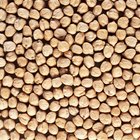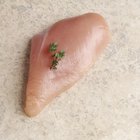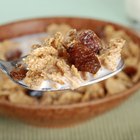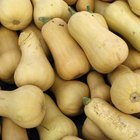
Gravy is typically made by using a thickener such as flour or cornstarch that works with the fats produced when roasting meat or poultry. While it takes a little longer, the same effect can be achieved by using the reduction method, in which the principle of evaporation replaces the action of a thickening agent. As the liquid simmers, it releases moisture in the form of steam, leaving fat solids, bits of meat, and concentrated flavorings behind. The amount of time you allow the reduction to simmer determines how thick the final gravy will be.
Step 1
Use the roasting pan that contains the meat drippings or transfer the drippings into a smaller saucepan. Place either the roasting pan or the saucepan over medium heat. Add a pat or two of butter to increase the fat content, if desired, and stir the fat and the bits of roasted meat until blended.
Step 2
Add finely chopped seasoning vegetables such as garlic or onions, if desired. Cook and stir them in the drippings for about two minutes, or until just tender.
Step 3
Add about 1 1/2 cups water, broth, wine or a combination of the three to the pan drippings, and scrape the bits of roasted meat from the bottom of the pan to incorporate them into the liquid.
Step 4
Bring the pan drippings and the water to a boil, stirring constantly. Reduce the heat to low and add any seasonings, including salt and pepper, to your taste. Do not cover the pan, and allow the mixture to simmer gently to allow the moisture to evaporate. Whisk the gravy as often as needed to eliminate any lumps that form during cooking.
Step 5
Remove the pan from the heat when you notice that the residue line on the inside has dropped from the original starting point to about halfway from the bottom, as this indicates that the gravy has been reduced by about half.
Related Articles

How to Use Lime Juice to Tenderize Steak

How to Separate Fat Without a Fat ...

How to Roast Chickpea Flour

How to Slow-Cook Peameal Bacon

How to Substitute Oleo for Cooking Oil ...

How to Cook Sauteed Chicken With White ...

How to Get Rid of Skunk Smell With ...

How to Locate a Missing Person in ...

How to Deep-Fry Chicken Nuggets

How to Make Creamy Alfredo Sauce With ...

How to Freeze Empanadas

How to Roast Maple and Brown Sugar ...

How to Thicken Beef Stroganoff

Calories in a Bowl of Raisin Bran Cereal

How to Cook Pulled Beef Without a Slow ...

How to Cook Pancetta

Can White Gravy Be Made With Almond ...

How to Cook Boneless Country Spare Ribs

How Many Calories Are in Butternut ...

How to Cook Beef Top Round Pot Roast
References
Tips
- To thicken a large amount of broth by this method for soup or stew, remove the meat and vegetables and return them to the pot along with any starchy ingredients such as cooked rice or noodles after the gravy has thickened to the desired consistency. This assures that you won't overcook the meat, vegetables, rice or noodles as the sauce thickens.
- The reduction method gives you control over how rich your gravy will be, and much of this depends on what you do with the pan drippings before adding any liquid. You can add more flavor by cooking them until the bits of meat are crispy and brown, and do the same with any seasoning vegetables you use. This flavor will be transferred to the cooking liquid you add and become even more concentrated as the sauce cooks down.
Writer Bio
Rachel Lovejoy has been writing professionally since 1990 and currently writes a weekly column entitled "From the Urban Wilderness" for the Journal Tribune in Biddeford, Maine, as well as short novellas for Amazon Kindle. Lovejoy graduated from the University of Southern Maine in 1996 with a Bachelor of Arts in English.
Photo Credits
Jupiterimages/liquidlibrary/Getty Images